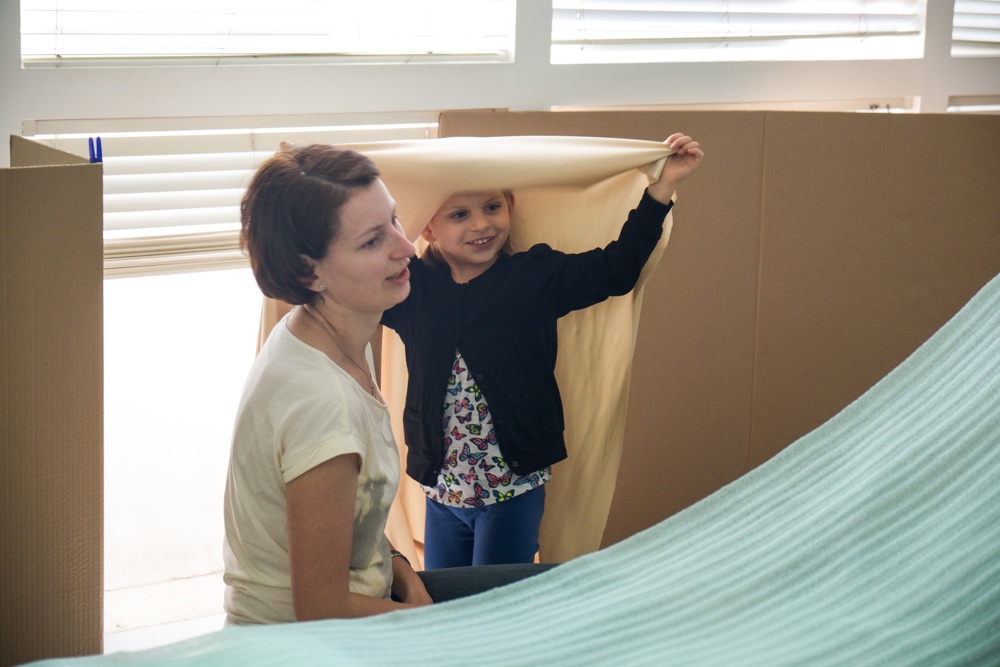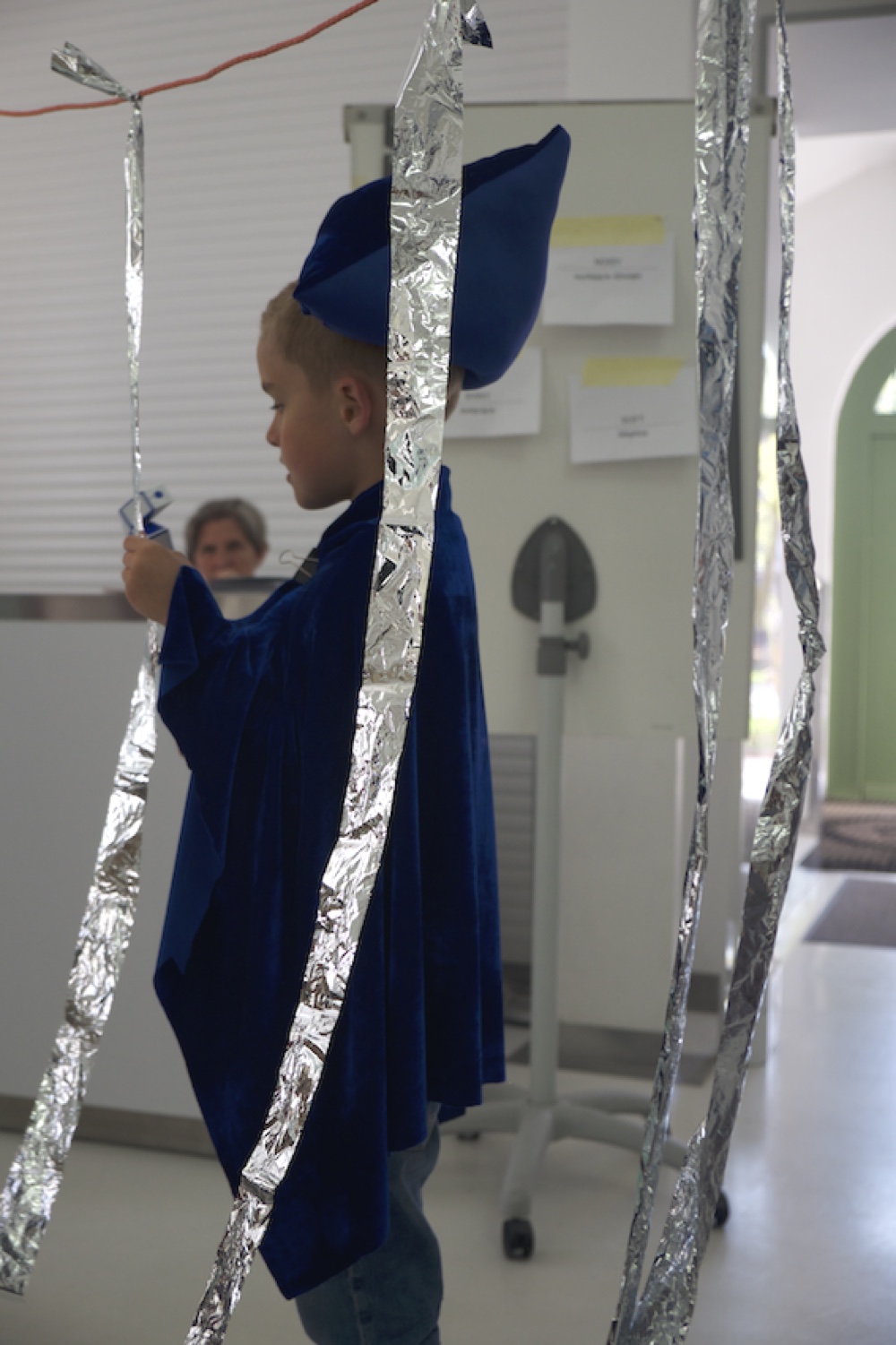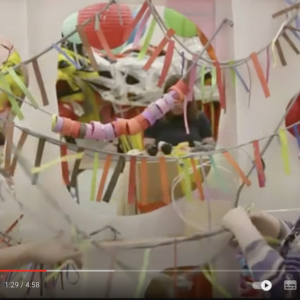To Conceal….
During the six week project Sensory Spaces: An Autism Friendly Project, the group explored different themes and actions, some of these were displayed through learning schemas. In week 2 we experimented with different ways to conceal ourselves and objects; schemas such as enveloping and enclosure were exhibited by the group. These patterns of learning and play were displayed throughout the project, with some children identifying with them more than others. I find it really interesting identifying different schemas in the group. Not all children learn in this way but it’s helpful to familiarise yourself with schemas, as they can help you to design a project or theme an activity.


Hidden
All the children enjoyed wrapping fabrics around their bodies and heads, large pieces of cloth became costumes that disguised us, transforming us into new characters, shapes and forms.
One child seemed to gain a sense of security when he wore a lycra band around his stomach. He also found pleasure by biting into and stretching materials.



We wrapped objects in fabrics, experimenting with how they felt and sounded. Tights filled with dried beans made a contrasting sound when shook in a shiny, metal bowl to when muffled in a soft, woollen jumper. Feeling objects with bare skin was a different experience to when we touched them through stretchy lycra fabrics, or soft cottons.



Wrapped
It’s worth investing in fabrics that are good quality and natural. Scratchy or plastic fabrics won’t be sensory stimulating and children won’t respond well to them.
Take time to feel an array of fabrics yourself, against your hands, arms, cheeks (and even feet!). Which fabrics are enjoyable to the touch? I found that soft corduroy, velvet, cotton, brushed cotton, wool and silk worked well, but you may discover more options. Consider selecting un-patterned fabrics, as these could be over stimulating, distracting or even distressing for some children. Also, choose a colour palette – it’s aesthetically pleasing!


My handmade, soft sculptures were used to envelop, conceal, reveal and transform the group. Some of the sculptural pieces are filled with lavender, beans or sand, these were balanced on heads or used as pillows; the soft, gentle textures and scents created the calm environment that was captured as the project progressed.


Enveloped
Dens and constructed spaces were a continuing theme throughout the project and were created in many different ways. They allowed the participants to manage their interaction with the rest of the group and encouraged the exploration of objects and materials in their own time, (as this was a research project, this open-ended way of working was supported).
Projecting onto translucent fabrics was sensory-effective, as were the flexible, magnifying reading sheets. These could be clipped together and suspended to make interesting viewing walls that distorted the world around us.
With the use of fabrics and viewing filters, these spaces enveloped ourselves and the characters we transformed ourselves into, hidden worlds were created, time-machines were built, we discovered how to play with sound; by wrapping fabrics around objects and our hands. In later sessions dens became more structured.
Den building is such a resourceful learning tool that supports play, cognitive learning, problem solving and imagination. Consider making dens in the classroom, or if the weather is good, take some materials outside and see what can be constructed.
Consider: translucent fabrics, foam sheets, large acetate, OHPs, shadows, light, colour.



Immersed
Projections are a simple and effective way of immersing yourself in a new experience. The sensation of bathing in light and colour can dramatically change the atmosphere of a space and is another way to explore, to conceal… The warmth of the light was also well received.
I placed a regular old-school Over Head Projector inside a cardboard den (both indoors and outdoors), we experimented with moving the light by bending plastic mirrors on the light reflections.


Textured fabrics light up when placed on the OHP and materials such as lace or a knitted jumper can cast shadows and patterns on walls and bodies.
Consider: the low hum of the OHP might be distracting, so perhaps you could let the children take control of switching it on and off. I also always put safety visuals on the hot parts.
Revealed
It was interesting theming the weeks by an action, they were always interpreted in unique and unplanned ways. To conceal… worked on so many levels, we were able to explore different senses, it was physical; we moved around and played hide and seek. We used our bodies and objects to measure sound. We made shadows and created safe spaces for ourselves and each other. As with all of my projects, I develop them as an artist, rather than a specialist in Autism. I believe that’s a positive approach, as perhaps I’m more willing to take risks; I don’t know if it will work, therefore I’ll try it! But I’m always very aware of the health and safety of everyone in the group, and using fabrics that can be stretched and wrapped must always be used under supervision. If at any moment you don’t feel comfortable with how something is being used then discreetly remove it. Always ensure there are enough adults to support the group and that you feel comfortable with the activities you’re providing.
Happy experimenting!
See more posts from Sarah in this series by following this link: Sensory Spaces: An Autism-Friendly Project
evelynarts.moonfruit.com – work portfolio
evelynartsunique.com – online shop


